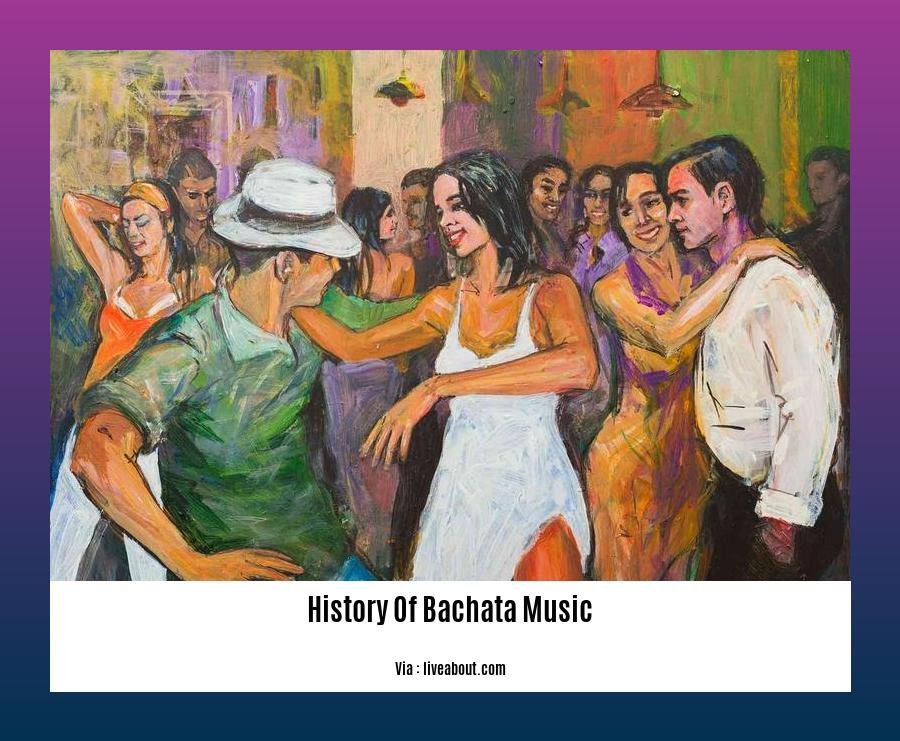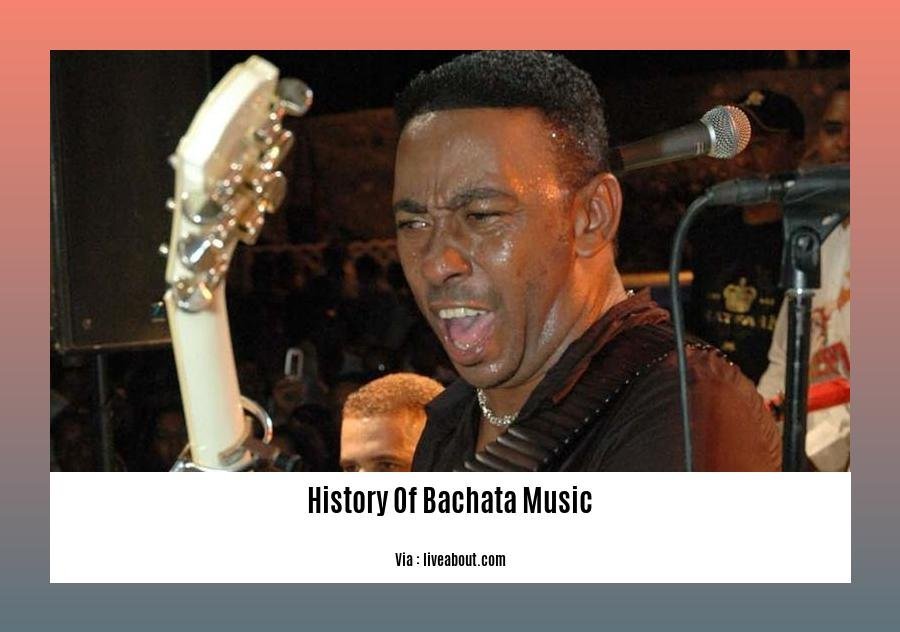With its intoxicating rhythms and heartfelt lyrics, bachata has captured the hearts of music lovers across the globe, weaving a captivating tale of passion, romance, and cultural pride. Join us as we embark on a journey through the history of bachata music, from its humble origins in the Dominican Republic to its meteoric rise as a global phenomenon. Discover the captivating stories behind the music’s evolution, the iconic figures who shaped its sound, and the social and cultural factors that fueled its rise to prominence. “Rhythm of Romance: A Journey Through the History of Bachata Music” is an immersive exploration that celebrates the rich heritage and vibrant spirit of this beloved genre.
Key Takeaways:
Bachata emerged in the Dominican Republic during the 20th century as a fusion of Spanish guitar music, African rhythms, Cuban son, and bolero.
Initially linked with the lower classes, bachata was commonly played in bars and brothels.
In the 1980s and 1990s, bachata gained widespread popularity as it became more electrified, developing its distinctive sound.
History of Bachata Music

Bachata, a compelling genre of Latin American music, emerged in the Dominican Republic, a nation steeped in rich musical traditions. Its birth can be traced back to the 20th century, where it captivated listeners with its infectious rhythms, soulful melodies, and heartfelt lyrics.
Humble Beginnings
In its early days, bachata was often associated with the lower classes, gaining popularity in the vibrant bars and brothels of the Dominican Republic. It was perceived as a genre of the marginalized, reflecting the struggles and joys of the working-class communities.
Fusion of Rhythms
Bachata’s unique sound is a testament to its diverse musical influences. It masterfully blends Spanish guitar music with the infectious rhythms of Africa, the soulful melodies of Cuban son, and the passionate lyrics of bolero. This fusion of genres created a captivating sound that resonated with audiences across the Dominican Republic.
Electrifying Transformation
The 1980s and 1990s marked a turning point for bachata music. It underwent a remarkable transformation, embracing electric guitars and synthesizers. This modernization gave bachata a distinctive sound that captivated a broader audience, propelling it to the forefront of Latin American music.
Global Recognition
The electrifying sound of bachata transcended borders, captivating audiences far beyond the Dominican Republic. It gained international recognition and popularity, becoming a beloved genre in countries across Latin America and the Caribbean. Its universal appeal lies in its ability to evoke emotions, tell stories, and inspire dancers with its infectious rhythms.
Enduring Legacy
Today, bachata stands as a celebrated genre, revered for its rich history, captivating rhythms, and heartfelt lyrics. It has left an indelible mark on the global music landscape, inspiring and influencing countless artists worldwide. The history of bachata music is a testament to the power of music to transcend boundaries, unite cultures, and captivate hearts.
Are you curious about the origins and evolution of Bachata dance? Explore the history of Bachata dance and discover its captivating journey from humble beginnings to global recognition!
Have you ever wondered how badminton became so popular in the Philippines? Dive into the history of badminton in the Philippines and uncover the fascinating story behind its rise to prominence.
Ever wondered how the rules of basketball came to be? Delve into the history of basketball rules and trace the evolution of the game’s regulations from its early days to the modern era.
Curious about the timeline of cinema’s development? Embark on a journey through the history of cinema timeline and witness the transformation of filmmaking from silent movies to the digital age.
Emergence as a distinct genre in the 1960s

In the vibrant streets of the Dominican Republic, where merengue and son ruled the airwaves, a new rhythm was taking shape, one that would soon captivate hearts and hips worldwide. This was the birth of bachata.
In the 1960s, bachata emerged as a distinct genre, its infectious beats echoing through the barrios of Santo Domingo. While its origins can be traced back to the fusion of various musical influences, including Spanish guitar, Cuban son, and African rhythms, it was in the 1960s that bachata truly found its voice.
Key figures like José Manuel Calderón and Luis Segura pioneered the genre, their passionate lyrics and catchy melodies resonating with the Dominican masses. Calderón’s 1962 hit “Borracho de amor” is widely regarded as the first recorded bachata song, paving the way for bachata’s rise to prominence.
Early bachata was often associated with the lower classes, played in bars and brothels. Its raw and emotional lyrics spoke to the struggles, joys, and heartbreaks of the working class, earning it a loyal following among the Dominican people.
Key Takeaways:
- Bachata emerged as a distinct genre in the 1960s, blending Spanish guitar, Cuban son, and African rhythms.
- José Manuel Calderón and Luis Segura are considered pioneers of the genre, with hits like “Borracho de amor” shaping its early sound.
- Bachata initially resonated with the Dominican working class, its lyrics expressing their struggles, joys, and heartbreaks.
- The genre’s raw and emotional style set it apart from other popular Latin American music of the time.
Sources:
Rise to International Fame in the 1990s
The infectious rhythms of bachata reverberated across borders in the 1990s, captivating audiences worldwide and propelling the genre to international stardom. This remarkable ascent can be attributed to several factors that transformed bachata into a global phenomenon.
A New Era of Electrification:
Throughout the 1980s, bachata began to embrace the electrifying power of electric guitars and synthesizers, amplifying its sound and attracting a broader audience. This sonic evolution paved the way for bachata to transcend its traditional confines and reach new listeners eager for a vibrant and energetic musical experience.
International Collaborations and Cross-Cultural Fusion:
Bachata’s appeal extended beyond the Dominican Republic as artists from various countries began to collaborate and infuse their own cultural influences into the genre. These cross-cultural collaborations resulted in a rich tapestry of bachata that resonated with diverse audiences worldwide. Iconic artists like Juan Luis Guerra and Grupo Aventura emerged during this period, captivating global listeners with their innovative fusions of bachata with other genres like merengue and pop.
The Power of Dance and Sensuality:
The sensual and expressive dance moves associated with bachata played a pivotal role in its international rise. The intimate connection and graceful movements of bachata captivated audiences, making it a popular choice for social dancing in clubs and dance halls around the world. The genre’s ability to evoke emotions and inspire movement further contributed to its widespread appeal.
Mainstream Media Exposure:
Bachata’s journey to international fame was further fueled by its increasing presence in mainstream media. The genre found its way into popular films, television shows, and radio stations, introducing bachata to a broader audience that had previously been unfamiliar with its captivating rhythms.
Key Takeaways:
The 1990s marked a turning point for bachata as it transcended its humble beginnings and ascended to international prominence.
The adoption of electric guitars and synthesizers amplified bachata’s sound, attracting a broader audience.
International collaborations and cross-cultural fusion enriched bachata’s musical tapestry, appealing to diverse listeners worldwide.
The sensual dance moves associated with bachata captivated audiences and made it a popular choice for social dancing.
Mainstream media exposure played a crucial role in introducing bachata to a global audience, further solidifying its international status.
Citations:
[1] “Bachata (music).” Wikipedia, Wikimedia Foundation, 2023.
[2] “The History of Bachata: From Humble Origins to Global Phenomenon.” Bailar Latino, 2023.
Contemporary Evolution and Fusion with Other Genres
Bachata’s journey through time has been nothing short of remarkable. It has evolved and fused with other genres, creating a unique and captivating sound that has captivated audiences worldwide.
In the 1980s, bachata’s evolution took a significant turn when artists began to experiment with electric guitars and synthesizers. This fusion of traditional bachata with modern sounds expanded the genre’s reach, appealing to a broader audience.
The 1990s witnessed bachata’s international breakthrough, as artists like Juan Luis Guerra and Aventura crossed borders and introduced the genre to the world. Their infectious fusion of bachata with other genres, such as pop, rock, and hip-hop, created a global sensation that propelled bachata to new heights.
Today, bachata continues to thrive as a dynamic and ever-evolving genre. Artists are pushing the boundaries, fusing bachata with a diverse range of musical influences, from Latin pop to R&B and even electronic dance music (EDM). This contemporary evolution and fusion with other genres has created a vibrant and eclectic soundscape that captivates listeners of all ages and backgrounds.
Key Takeaways:
Bachata’s evolution in the 1980s involved the integration of electric guitars and synthesizers, modernizing its sound and expanding its appeal.
In the 1990s, artists like Juan Luis Guerra and Aventura played a pivotal role in popularizing bachata internationally by fusing it with genres like pop, rock, and hip-hop.
Contemporary bachata continues to evolve with artists experimenting and fusing bachata with diverse genres like Latin pop, R&B, and EDM, creating a vibrant and multifaceted soundscape.
The fusion of bachata with other genres has broadened its appeal and attracted a global audience, making it one of the most popular Latin music genres worldwide.
[1] https://en.wikipedia.org/wiki/Bachata_(music)
[2]
FAQ
Q1: When did bachata music originate?
A1: Bachata music originated in the Dominican Republic in the 20th century, influenced by a fusion of various musical styles, including European, African, and Latin American rhythms.
Q2: What are the essential instruments used in bachata music?
A2: The typical bachata ensemble consists of five instruments: requinto (lead guitar), segunda (rhythm guitar), bass guitar, bongos, and güira, each contributing to the characteristic sound of bachata.
Q3: Who is credited with releasing the first bachata song?
A3: The first official bachata song, “Borracho de Amor,” was recorded in 1962 by José Manuel Calderón, a Dominican musician, who is widely recognized as a pioneer of the genre.
Q4: When did bachata gain international recognition?
A4: Bachata’s popularity extended beyond the Dominican Republic in the 1990s, thanks to the success of prominent bachata artists such as Juan Luis Guerra and the group Aventura, who helped introduce the genre to a global audience.
Q5: What is the significance of bachata music?
A5: Bachata is considered an important part of Dominican culture and has become a widely recognized genre in Latin music, capturing the hearts of people worldwide with its romantic and soulful melodies that often explore themes of love, heartbreak, and everyday life.
- Senior at What Age: Benefits & Eligibility Guide - March 29, 2025
- Unlocking Senior Benefits: How Old is a Senior? Your Complete Guide - March 29, 2025
- Master Russian Politeness:A Guide to Saying Please - March 29, 2025
















